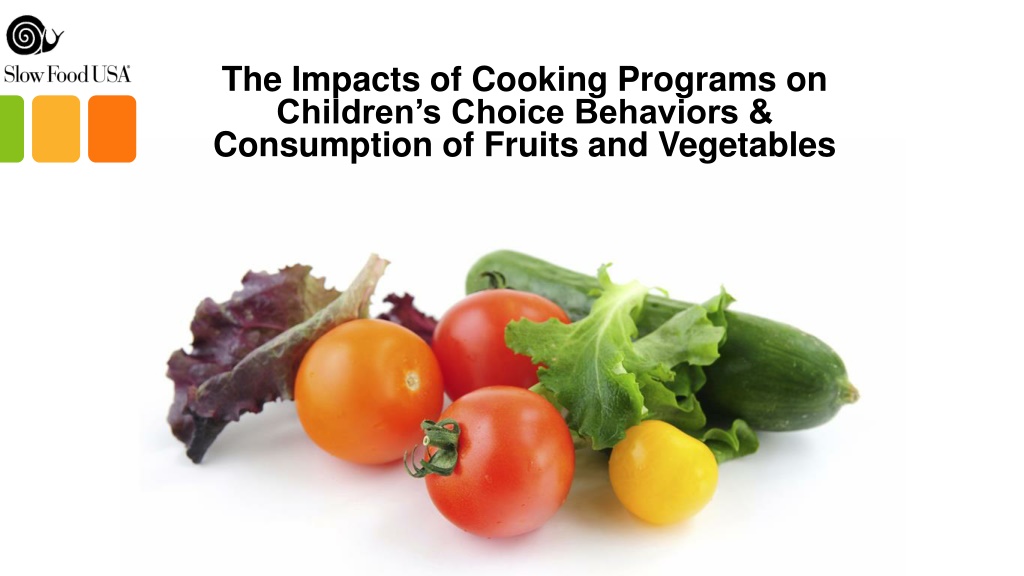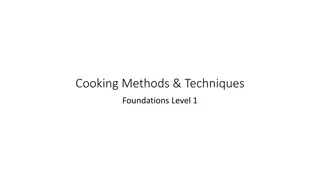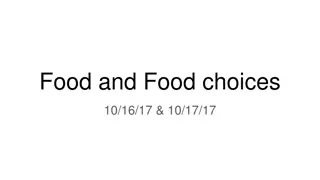Impact of Cooking Programs on Children's Food Choices & Behaviors
Cooking programs have a positive impact on children's food-related preferences, attitudes, and behaviors. Studies show increased cooking confidence, vegetable consumption, self-efficacy, and willingness to try new foods among children participating in cooking interventions. These programs help improve attitudes towards fresh foods and increase fruit and vegetable intake, promoting healthier eating habits among children.
Download Presentation

Please find below an Image/Link to download the presentation.
The content on the website is provided AS IS for your information and personal use only. It may not be sold, licensed, or shared on other websites without obtaining consent from the author. Download presentation by click this link. If you encounter any issues during the download, it is possible that the publisher has removed the file from their server.
E N D
Presentation Transcript
The Impacts of Cooking Programs on Children s Choice Behaviors & Consumption of Fruits and Vegetables
What are the impacts of cooking programs on children's eating behavior, food choices, and attitudes towards fresh food?
Study 1: Research Review of Studies on Cooking Interventions Article & Program Details The Impact of Cooking Classes on Food-Related Preferences, Attitudes, and Behaviors of School- Aged Children: A Systematic Review of the Evidence, 2003-2014 by Derek Hersch, Laura Perdue, Teresa Ambroz, and Jackie L. Boucher (2014) Program Outcomes Some of the major outcomes found in the intervention groups within these studies included: increased cooking confidence increased vegetable consumption increased self-efficacy greater willingness to try new foods increased vegetable preferences increased fiber consumption Main Findings Cooking programs might positively influence children s food-related preferences, attitudes, and behaviors, although it is difficult to determine which pathways to utilize The authors conducted a search on various research databases to find studies involving cooking education programs with children The studies included focused on children aged 5 to 12 years old and the interventions took place in a school or community setting The authors focused on eight articles from their search and assessed the impacts of the interventions on students food attitudes Despite the method of intervention on students, each program had a significant effect on 1 or more of its participants food-related preferences, attitudes, and behaviors
Study 1 Data: Research Review of Studies on Cooking Interventions The Impact of Cooking Classes on Food-Related Preferences, Attitudes, and Behaviors of School-Aged Children: A Systematic Review of the Evidence, 2003-2014 by Derek Hersch, Laura Perdue, Teresa Ambroz, and Jackie L. Boucher (2014) Program Outcomes Article Details Main Findings Authors conducted a database search of cooking intervention studies among elementary school students Most common outcomes were increases in: -self-efficacy -cooking confidence -vegetable preferences -fiber intake Cooking programs might positively influence children s food- related preferences, attitudes, and behaviors
Study 2: Cooking Classes & Food Preparation Education Article & Program Details Cooking Classes Increase Fruit and Vegetable Intake and Food Safety Behaviors in Youth and Adults by Barbara J. Brown and Janice R. Hermann (2005) Program Outcomes Increased fruit intake: 1.1 to 2.3 servings daily for youth 1.5 to 2.1 servings daily for adults Main Findings Classes were effective in: Increasing fruit and vegetable intake Increased vegetable intake: 1.4 to 2.4 servings daily for youth 2.1 to 2.7 servings daily for adults Improving food safety behaviors A program developed by the Oklahoma Cooperative Extension service implemented cooking classes with fruits and vegetables for participants aged 12-57 in 28 counties over a 2-month period 602 participants (229 youth, 373 adults) Classes included learning to cook via stir- fry, baking, grilling, steaming, etc. Although both youth & adults participated and learned from the program, authors noted that youth particularly benefitted Increased food safety behaviors: 38% of youth & 11% of adults increased behavior of washing hands 29% of youth & 8% of adults increased behavior of washing food during preparation
Study 2 Data: Cooking Classes & Food Preparation Education Cooking Classes Increase Fruit and Vegetable Intake and Food Safety Behaviors in Youth and Adults by Barbara J. Brown and Janice R. Hermann (2005) Program Findings Classes increased fruit & vegetable intake [1.1-2.3 & 1.5- 2.1 fruit servings for youth & adults; 1.4- 2.4 & 2.1-2.7 vegetable servings for youth & adults] Cooking classes on fruits and vegetables Learned to cook via stir-fry, baking, grilling, steaming, etc. Participants aged 12- 57 in 28 counties over a 2-month period 602 participants (229 youth, 373 adults) Authors noted that youth particularly benefitted from this program Classes helped increase food safety behaviors (washing hands & food)
Study 2 Data: Cooking Classes & Food Preparation Education Cooking Classes Increase Fruit and Vegetable Intake and Food Safety Behaviors in Youth and Adults by Barbara J. Brown and Janice R. Hermann (2005) Youth s and Adult s Increase in Fruit & Vegetable Consumption Pre- and Post-Study 6 5 4 2.7 servings 2.1 servings 3 2.1 servings 2 1.5 servings 2.4 servings 2.3 servings 1 1.4 servings 1.1 servings 0 FRUITS (PRE-STUDY) FRUITS (POST-STUDY) VEGETABLES (PRE-STUDY) Adults VEGETABLES (POST- STUDY) Youth
Study 3: Cooking Lessons & Food Literacy Education Article & Program Details Cook it Up! A Community-based cooking program for at-risk youth: overview of a food literacy intervention by Heather MC Thomas and Jennifer D. Irwin (2011) Program Outcomes Enhanced participants self- efficacy with cooking Main Findings Intervention was effective in: Increasing confidence and pride in cooking abilities The intervention provided a unique way to improve the important [culinary] life skills such as: proper food selection Inspired some youth to seriously consider post- secondary school education in this [culinary] field as a future academic goal London Community Resource Center developed an 18-month community based cooking program taught by local chefs to improve food literacy and cooking skills Participants included 8 at-risk youth at average age of 14.6 years preparation storage Classes included: bi-monthly 2-hour cooking sessions Monthly visits to farms and farmers markets (to heighten familiarity with local agriculture) usage
Study 3 Data: Cooking Lessons & Food Literacy Education Cook it Up! A Community-based cooking program for at-risk youth: overview of a food literacy intervention by Heather MC Thomas and Jennifer D. Irwin (2011) 18-month cooking program for at-risk teenage youth Intervention was effective in increasing pride & confidence in cooking skills Improved culinary life skills (food selection, preparation) Enhanced participants self-efficacy Monthly farmers market visits Bi-monthly 2-hr cooking sessions PROGRAM OUTCOMES MAIN FINDINGS
Study 4: Cooking Classes, Health & Nutrition Education Article & Program Details When Chefs Adopt a School? An Evaluation of a Cooking Intervention in English Primary Schools by M. Caraher, A. Seeley, M. Wu, and S. Lloyd (2012) Program Outcomes Average reported cooking score increased from 3.09 to 3.35 points post-sessions with chefs Main Findings Sessions were effective in creating gains in: Cooking skills UK program designed to have professional chefs teach food health, nutrition, and cooking in schools Participants aged 9-11 years across 4 primary schools Classes included three cooking sessions for each class for up to one year Increased vegetable consumption from 2.24 to 2.46 points post-sessions with chefs Confidence to prepare and ask for ingredients at home Authors suggest that there is a need for evaluation of such programs to fine tune their impacts and consistency in producing benefits
Study 4 Data: Cooking Classes, Health & Nutrition Education When Chefs Adopt a School? An Evaluation of a Cooking Intervention in English Primary Schools by M. Caraher, A. Seeley, M. Wu, and S. Lloyd (2012) Gains in cooking skills Professional chefs taught health & nutrition through cooking classes 4 primary schools, 9- 11 yr. old participants 3 cooking sessions per class (1 year) Outcomes More confidence to prepare and ask for ingredients at home Cooking score increased from 3.09 to 3.35 points (average) Main Findings Vegetable consumption increased from 2.24 to 2.46 points (average) Program
Study 5: Cooking Lessons & Food Tasting Sessions Article & Program Details Cooking with Kids Positively Affects Fourth Graders Vegetable Preferences and Attitudes and Self-Efficacy for Food and Cooking by L. Cunningham-Sabo and B. Lohse (2013) Program Outcomes >3 times greater increase in self- efficacy among program participants than non-intervention participants Main Findings Intervention was effective in increasing: Vegetable preferences Cooking attitudes Self-efficacy Cooking with Kids (CWK) food education program led by trained food educators to improve food attitudes among 4th graders CWK was originally aimed at assisting low- income Hispanic students, but the study proved CWK curriculum can be generalizable to other audiences (e.g. non- Hispanic students) 4 public schools,12 classes, 257 students, Classes included 1 introductory lesson, three 2-hour cooking lessons & three 1-hour fruit and vegetable tasting sessions Findings of increased vegetable preference particularly among CWK participants The authors concluded that non-cookers, especially boys, benefitted from this intervention, but the study proved CWK curriculum can be generalizable to other audiences (e.g. non-Hispanic students) Significant improvement among boys with no cooking experience
Study 5 Data: Cooking Lessons & Food Tasting Sessions Cooking with Kids Positively Affects Fourth Graders Vegetable Preferences and Attitudes and Self-Efficacy for Food and Cooking by L. Cunningham-Sabo and B. Lohse (2013) Program Details Program Outcomes Cooking with Kids (CWK) teaches food education Main Findings CWK significantly improved students vegetable preferences, food attitudes, and self- efficacy toward food & cooking, which are factors important to obesity prevention >3x increase in participants self-efficacy 4 schools, 257 4th graders Intervention was effective in increasing: Vegetable preferences Increased veggie preference 2-hr. cooking sessions Cooking attitudes Significant improvement among boys with no cooking experience 1-hr. fruit/veggie tasting sessions Self-efficacy
Study 6: Cooking, Nutrition & Gardening Lessons Article & Program Details LA Sprouts: a Garden-Based Nutrition Intervention Pilot Program Influences Motivation and Preferences for Fruits and Vegetables in Latino Youth by Nicole M. Gatto, Emily E. Ventura, Lauren T. Cook, et al. (2012) Program Outcomes 16% greater increase in vegetable preferences when compared with control group Main Findings Classes were effective in: Improving perceptions of vegetables (particularly for female and overweight participants) Participants were 54% more likely than control subjects to report that vegetables from the garden taste better than [those] from the store Improved attitudes toward fruits and vegetables LA Sprouts created a garden-based intervention for students taught by certified staff to influence dietary intake behavior 104 mostly Latino 4th & 5th grade participants Year-long intervention of 90-minute interactive classes at a community garden with cooking/nutrition classes, 45-min gardening lessons & visits to farmers markets Increased preferences for target fruits and vegetables 3.3 point change increase in self- efficacy, compared with 0.4 point change for control group
Study 6 Data: Cooking, Nutrition & Gardening Lessons LA Sprouts: a Garden-Based Nutrition Intervention Pilot Program Influences Motivation and Preferences for Fruits and Vegetables in Latino Youth by Nicole M. Gatto, Emily E. Ventura, Lauren T. Cook, et al. (2012) PROGRAM 1-yr. garden-based intervention for 104 4th & 5th grade students: 90-min. interactive classes at garden [cooking/nutrition & gardening] Visits to farmers markets MEASURED OUTCOMES INTERVENTION GROUP CONTROL GROUP SELF-EFFICACY 3.3 point (%) change increase vs. 0.4 point (%) change increase VEGETABLE PREFERENCES 1.8 point (%) increase vs. 1.3 point (%) decrease
Study 7: Kitchen & Garden Lessons Article & Program Details Expanding Children s Food Experiences: the Impact of a School-Based Kitchen Garden Program byLisa Gibbs, Petra K, Staiger, Britt Johnson, et al. (2012) Program Outcomes Post-program demonstrated increased odds of willingness to try new foods if: They never tried it (29.8-35.4%) (from baseline to follow-up) Cooked it themselves (38.5-51%) Grew it (33.4-38.7%) Main Findings Program was effective in: Increasing vegetable intake Increasing willingness to try new foods Increasing the range of foods eaten by participants Stephanie Alexander Kitchen Garden (SAKG) program aimed at increasing 8-12 year old students appreciation of diverse, healthy food Main themes that emerged: Children eating/appreciating new food Impacts on student engagement Transfer of program impacts to home environment Improving perceptions of food as healthier, more fresh 6 intervention & 6 control schools, 764 children grades 3-6 Classes consisted of 90-minute kitchen courses and 30-45 minute garden courses
Study 7 Data: Kitchen & Garden Lessons Expanding Children s Food Experiences: the Impact of a School-Based Kitchen Garden Program byLisa Gibbs, Petra K, Staiger, Britt Johnson, et al. (2012) PROGRAM: 6 intervention & 6 control schools 764 children, 3rd-6th grade 90-min. kitchen courses & 30-45 min. garden courses STUDY OUTCOMES PRE-STUDY POST-STUDY PRE-STUDY POST-STUDY [willingness to try new food if cooked it themselves] [willingness to try new food if cooked it themselves] [willingness to try new food if grew it themselves] [willingness to try new food if grew it themselves] GROUPS 38.5% 51% 33.4% 38.7% PROGRAM 31.7% 33.6% 25.1% 22.9% COMPARISON
Increased fruit and vegetable preferences Improving perceptions of vegetables Increasing pride in cooking abilities What are the impacts of cooking programs on children's eating behavior, food choices, and attitudes towards fresh food? Cooking Interventions Higher cooking self- efficacy Improved food safety behavior Increased consumption of fruits and vegetables Increased willingness to try new foods
What are the impacts of cooking programs on children's eating behavior, food choices, and attitudes towards fresh food? Increased fruit & veggie intake: (F) 1.1 to 2.3 (V) 1.4 to 2.4 servings/day Average cooking score increased from 3.09 to 3.35 examples of programs measured outcomes various studies demonstrate the positive impacts of cooking classes on food behavior Willingness to try new food (if they cooked it themselves) increased from 38.5% to 51% 3.3 point (%) change increase in self-efficacy























